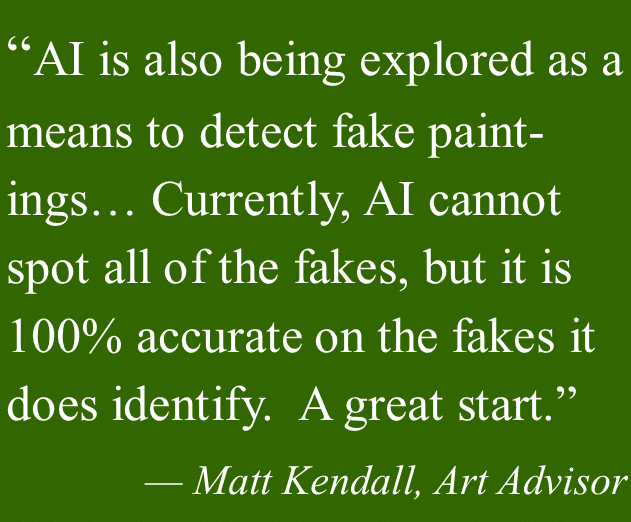In this week’s post for our blog mini-series, I’ve decided to switch up the format a bit and conduct an interview-style blog with the art dealer and gallery owner Matt Kendall. I had recently read an article in the May 21, 2018 edition of Bloomberg Business on AI and how it could emulate, and produce works eerily similar to, the old world masters. When I brought this up to Ned Montag, he immediately put me in touch with Matt and what follows is that interview. It was very interesting to hear his perspectives on how AI might disrupt the art industry, especially the aspects of art that are spatiotemporal in nature (i.e., art galleries, art storage, etc.)
As we discussed in last week’s blog, there could definitely be new opportunities AS WELL AS unintended consequences for an industry where AI is becoming a burgeoning force. The art world is no different.
In addition to the interview, Matt turned me on to THIS ARTICLE as well, which is pretty interesting (and scary!)
Enjoy.
* * *
SW: How does a transaction work now that a computer is involved? Who owns the intellectual rights, and who pays taxes, or is taxed, on the transaction?
MK: Even though a computer is involved, the person or entity that created the AI receives the income and owns the intellectual rights. Taxes are paid as they would be for any product or service.
SW: How do you “value” new and/or A.I. works of art? I mean, a computer can produce several different “styles” of paintings, how do you value such a diverse style (or lack of style)? Who sets the market for this kind of stuff?
MK: Art created by AI is really in the “proof of concept” stage. In February, a well-known collector named Nicolas Laugero-Lasserre paid $12,000 to Obvious, the group that created the AI behind it. Probably not a bad investment, in the same way that buying the original Macintosh computer and never taking it out of the box would have been a smart play.
If this concept takes off, so will the value of the painting.
SW: How fast can these works be produced?
MK: Once data is input, AI painters can create 1,000 original artworks with the tap of the enter key.
SW: Does this help galleries at all with a leaner inventory, depending on how fast these works can be produced?
MK: I don’t see galleries taking on AI “artists” in the near future. I suspect this will be more of an online platform.
SW: This is so new I imagine there probably isn’t one yet, but is there a “resale” market for these assets?
MK: There are online marketplaces popping up to sell digital art, and this may be the future for AI generated works.
Essentially these sites cryptographically register art with a token on a blockchain. This keeps the images original, or “rare”, and allows them to be bought and sold.
SW: What’s the pricing like on something like the commission of computer generated art? If I wanted a computer to make me a painting, what would I pay? WHO would I pay?
MK: You would pay the person or entity that created the AI.
Afterthoughts from Matt Kendall:
In my opinion, AI lacks thought and creativity. It can accept the data, and then based on that data create something original. Being original is not akin to being art, at least in my book. The “artists” in this story are the people that created the AI, then select the images to feed into it. Feeding 100 portraits into the system yields one set of “artworks.” Adding 15 abstract expressionist paintings to the mix will yield a vastly different set of “artworks.” The person feeding the data to the AI is the artist. One day AI may be creative, but not today.

AI is also being explored as a means of detecting fake paintings. Developers feed images of authentic works into the system, then charge the computer with determining whether or not a painting is a fake. Currently, AI cannot spot all of the fakes, but it is 100% accurate on the fakes it does identify. A great start.


